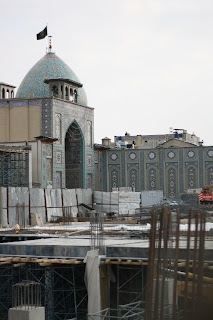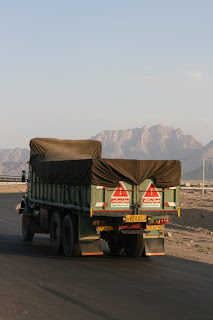After Isfahan, we drove on (past
another huge Carrefour-style „hypermarket“ - but no, we resisted
to enter this time) to the desert city Yazd. On the border of huge
Iranian deserts, we looked at the picturesque adobe city center with
its characteristic wind towers. Again, in the sun it was quite hot,
but any shadow was relieving and the dry air was amazingly
comfortable.
 |
| Roadside impressions |
 |
| A typical windtower in downtown Yazd. |
 |
| Wooden mosque door, centuries old. |
 |
| and even older. |
 |
| Under the shady arches, it was remarkably cool. |
 |
| Construction work. Buildings are still built with the traditional clay method. |
 |
| A mixture of clay and straw is used to cover bricks. |
|
 |
| A local blacksmith. |
 |
| Imam Ali, whom you can often see on wall, trucks etc. His role as successor of Mohammed was the reason for the Shia-Sunni split. |
 |
| A little girl's proper praying instructions. |
 |
| As a proper housewife, Katha is shopping pots and pans. |
 |
| A famous temple of the Zoroastrians is located in Yazd. |
 |
| with an eternal flame, a woodfire that burns since 1500 years. |
 |
| The temple itself is rather neutral and a sharp contrast to all the mosques. |
We stayed at a
newly renovated guesthouse 25km outside of the city, and for a bargain price we slept in
the courtyard and enjoyed the breakfast. With Kalimero
standing/driving in the sun all day, we preferred cool air over the
35° interior, and the atmosphere was truly one of a kind.
We enjoyed the remoteness of the desert
(no head-scarf, no t-shirt, showering naked outside the car!), gazed
at the stars and our campfire. After a quiiiiiiiet night, we
navigated back to tarmac to get the 500km to Persepolis done.
 |
On the long driving days, we did not want to drink only water or Coke.
We found quite a refreshing alternative: BEER! Of course, alcohol-free, but very drinkable. |
|
 |
| an extremly delicious refreshment (and almost a full meal): fresh carrot juice with ice cream. |
Persepolis is the city of the Persian
rulers around 500 BC, and today an astonishing lot of its detailed
carvings are still intact – also thanks to Alexander the Great, who
inadvertedly burnt the city down over 2000 years ago. The ashes and
following millenia covered the structures and kept them for the
afterworld.
We arrived in the evening, just to be
woven on a „parking and camping“ ground – well, a huge area of
asphalt next to a park. Almost empty when we came at 7pm, the place
filled up until 10pm and (usual pitcure in Iran) dozens of families
shared our camping space.
Being prototypics German, we stood at
the gates at 8am, just when the antique city opened the next morning.
Because, being German, we wanted to evade the heat coming in from
10am on (not a single tree in the whole area), and we had hardly use
for the Farsi guides. So, we had the place rather empty and could
easily look at the hundreds if carved figures and structures. Really
amazing, how masonry was advanced 2500 years ago.
 |
| The carvings are well-secured nowadays, barriers and defined boardwslks to protect them against vandalism. This was not always the case, as it seems. |
Even more, the ferry to Dubai runs
Saturdays and Mondays (although a travel agency told us Mondays and
Wednesdays with a car), and we were advised to try to be there the
day before departure: Iranian customs would be notorious for their
export buerocracy.
The day before departure is Friday = generally
dead streets until 6pm in southern Iran, and probably so is the ferry
ticket agency. So, our time plan was even more compressed, and we rushed on to go to Bandar Abbas.






































Keine Kommentare:
Kommentar veröffentlichen